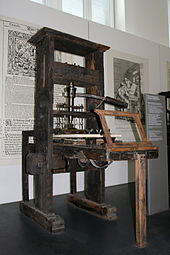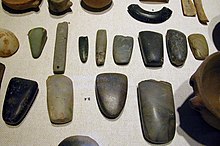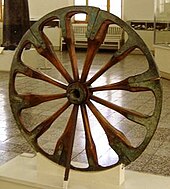Posted by Amisha Sanhotra
Posted on 04:16
with No comments
Technology ("science of craft", from Greek τέχνη, techie, "art, skill, cunning of hand"; and -λογία, -is the collection of techniques, skills, methods and processes used in the production of goods or services or in the accomplishment of objectives, such as scientific investigation. Technology can be the knowledge
of techniques, processes, etc. or it can be embedded in machines,
computers, devices and factories, which can be operated by individuals
without detailed knowledge of the workings of such things.
The human species' use of technology began with the conversion of natural resources into simple tools. The prehistoric discovery of how to control fire and the later Neolithic Revolution increased the available sources of food and the invention of the wheel helped humans to travel in and control their environment. Developments in historic times, including the printing press, the telephone, and the Internet, have lessened physical barriers to communication and allowed humans to interact freely on a global scale. The steady progress of military technology has brought weapons of ever-increasing destructive power, from clubs to nuclear weapons.
Technology has many effects. It has helped develop more advanced economies (including today's global economy) and has allowed the rise of a leisure class. Many technological processes produce unwanted by-products, known as pollution, and deplete natural resources, to the detriment of Earth's environment. Various implementations of technology influence the values of a society and new technology often raises new ethical questions.
The term "technology" rose to prominence in the 20th century in connection with the Second Industrial Revolution. The term's meanings changed in the early 20th century when American social scientists, beginning with Thorstein Veblen, translated ideas from the German concept of Technique into "technology". In German and other European languages, a distinction exists between technique and technologies
that is absent in English, which usually translates both terms as
"technology". By the 1930s, "technology" referred not only to the study of the industrial arts but to the industrial arts themselves.
The word "technology" can also be used to refer to a collection of techniques. In this context, it is the current state of humanity's knowledge of how to combine resources to produce desired products, to solve problems, fulfill needs, or satisfy wants; it includes technical methods, skills, processes, techniques, tools and raw materials. When combined with another term, such as "medical technology" or "space technology", it refers to the state of the respective field's knowledge and tools. "State-of-the-art technology" refers to the high technology available to humanity in any field.
Technology can be viewed as an activity that forms or changes culture.Additionally, technology is the application of math, science, and the
arts for the benefit of life as it is known. Not all technology enhances culture in a creative way; technology can also help facilitate political oppression and war via tools such as guns. As a cultural activity, technology predates both science and engineering, each of which formalize some aspects of technological endeavor.
Man's technological ascent began in earnest in what is known as the Neolithic period ("New stone age"). The invention of polished stone axes was a major advance that allowed forest clearance on a large scale to create farms.
Metal tools
Continuing improvements led to the furnace and bellows and provided the ability to smelt and forge native metals (naturally occurring in relatively pure form).[36] Gold, copper, silver, and lead, were such early metals. The advantages of copper tools over stone, bone, and wooden tools were quickly apparent to early humans, and native copper was probably used from near the beginning of Neolithic times (about 8000 BC).[37] Native copper does not naturally occur in large amounts, but copper ores are quite common and some of them produce metal easily when burned in wood or charcoal fires. Eventually, the working of metals led to the discovery of alloys such as bronze and brass (about 4000 BC). The first uses of iron alloys such as steel dates to around 1400 BC.
Starting in the United Kingdom in the 18th century, the Industrial Revolution was a period of great technological discovery, particularly in the areas of agriculture, manufacturing, mining, metallurgy and transport, driven by the discovery of steam power. Technology took another step in a second industrial revolution with the harnessing of electricity to create such innovations as the electric motor, light bulb and countless others. Scientific advancement and the discovery of new concepts later allowed for powered flight, and advancements in medicine, chemistry, physics and engineering.
The 20th century brought a host of innovations. In physics, the discovery of nuclear fission has led to both nuclear weapons and nuclear power. Computers were also invented and later miniaturized utilizing transistors and integrated circuits. information technology subsequently led to the creation of the Internet, which ushered in the current Information Age. Humans have
The human species' use of technology began with the conversion of natural resources into simple tools. The prehistoric discovery of how to control fire and the later Neolithic Revolution increased the available sources of food and the invention of the wheel helped humans to travel in and control their environment. Developments in historic times, including the printing press, the telephone, and the Internet, have lessened physical barriers to communication and allowed humans to interact freely on a global scale. The steady progress of military technology has brought weapons of ever-increasing destructive power, from clubs to nuclear weapons.
Technology has many effects. It has helped develop more advanced economies (including today's global economy) and has allowed the rise of a leisure class. Many technological processes produce unwanted by-products, known as pollution, and deplete natural resources, to the detriment of Earth's environment. Various implementations of technology influence the values of a society and new technology often raises new ethical questions.
The spread of paper and printing to the West, as in this printing press, helped scientists and politicians communicate their ideas easily, leading to the Age of Enlightenment; an example of technology as cultural force
The word "technology" can also be used to refer to a collection of techniques. In this context, it is the current state of humanity's knowledge of how to combine resources to produce desired products, to solve problems, fulfill needs, or satisfy wants; it includes technical methods, skills, processes, techniques, tools and raw materials. When combined with another term, such as "medical technology" or "space technology", it refers to the state of the respective field's knowledge and tools. "State-of-the-art technology" refers to the high technology available to humanity in any field.
The invention of integrated circuits and the microprocessor (here, an Intel 4004 chip from 1971) led to the modern computer revolution.
Science, engineering and technology
Antoine Lavoisier conducting an experiment with combustion generated by amplified sun light
Main articles: History of technology, Timeline of historic inventions, and Timeline of electrical and electronic engineering
Paleolithic (2.5 million YA – 10,000 BC)
A primitive chopper
Further information: Outline of prehistoric technology
The use of tools by early humans was partly a process of discovery and of evolution. Early humans evolved from a species of foraging hominids which were already bipedal,[21] with a brain mass approximately one third of modern humans.[22] Tool use remained relatively unchanged for most of early human history. Approximately 50,000 years ago, the use of tools and complex set of behaviors emerged, believed by many archaeologists to be connected to the emergence of fully modern language.[23]Stone tools
Hand axes from the Acheulian period
A Clovis point, made via pressure flaking
Neolithic through classical antiquity (10,000 BC – 300 AD)
An array of Neolithic artifacts, including bracelets, axe heads, chisels, and polishing tools
Metal tools
Continuing improvements led to the furnace and bellows and provided the ability to smelt and forge native metals (naturally occurring in relatively pure form).[36] Gold, copper, silver, and lead, were such early metals. The advantages of copper tools over stone, bone, and wooden tools were quickly apparent to early humans, and native copper was probably used from near the beginning of Neolithic times (about 8000 BC).[37] Native copper does not naturally occur in large amounts, but copper ores are quite common and some of them produce metal easily when burned in wood or charcoal fires. Eventually, the working of metals led to the discovery of alloys such as bronze and brass (about 4000 BC). The first uses of iron alloys such as steel dates to around 1400 BC.
Energy and transport
The wheel was invented circa 4000 BC.
Main article: History of transport
The invention of the wheel revolutionized trade and war. It did not
take long to discover that wheeled wagons could be used to carry heavy
loads. Fast (rotary) potters' wheels enabled early mass production of pottery. But it was the use of the wheel as a transformer of energy (through water wheels, windmills, and even treadmills) that revolutionized the application of nonhuman power sources.Medieval and modern history (300 AD – present)
Main articles: Medieval technology, Renaissance technology, Industrial Revolution, Second Industrial Revolution, Information Technology, and Productivity improving technologies (economic history)
Innovations continued through the Middle Ages with innovations such as silk, the horse collar and horseshoes in the first few hundred years after the fall of the Roman Empire. Medieval technology saw the use of simple machines (such as the lever, the screw, and the pulley) being combined to form more complicated tools, such as the wheelbarrow, windmills and clocks.
The automobile revolutionized personal transportation.
The 20th century brought a host of innovations. In physics, the discovery of nuclear fission has led to both nuclear weapons and nuclear power. Computers were also invented and later miniaturized utilizing transistors and integrated circuits. information technology subsequently led to the creation of the Internet, which ushered in the current Information Age. Humans have










0 comments:
Post a Comment